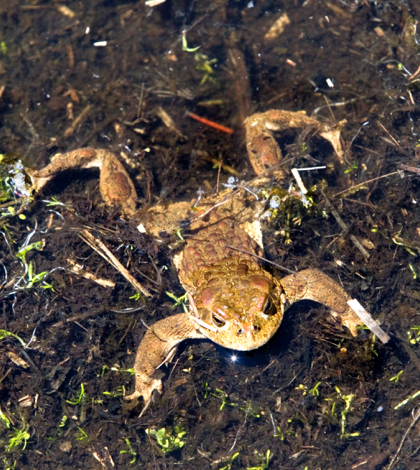More than 1.8 million acres, equal to nearly 3,000 square miles, of protected “critical habitat” was designated by the U.S. Fish and Wildlife Service on Thursday for three endangered amphibians – the Sierra Nevada yellow-legged frog, the Yosemite toad and the northern population of the mountain yellow-legged frog.
In 2000, the Center for Biological Diversity (CBD) had petitioned to protect the Yosemite toad and both of the frogs. The Fish and Wildlife Service had listed the two yellow-legged frogs as endangered in 2014. The Yosemite toad was listed as threatened.
“Yellow-legged frogs and Yosemite toads were a common sight in the high Sierras until fairly recently,” said Jeff Miller of the CBD. “Their rapid declines are a warning of the failing health of our high Sierra ecosystems. Critical habitat will not only protect these amphibians but will also protect water bodies, riparian areas and wet meadows that provide fresh, clean water for many Californians and habitat for other species.”
Despite some 20,000 public comments and the infighting between federal agencies, the Fish and Wildlife Service is expected to make the designation final today. In doing so it will influence logging, hydroelectric dam operations and grazing in the region as well as land management decisions from Fresno to Lassen. The region encompasses 16 counties.
The Sierra Nevada and mountain yellow-legged frogs have declined by about 90 percent throughout the Sierras in the past few decades due to habitat destruction and degradation, disease, predation by non-native trout, pesticides and climate change. Yosemite toad populations have been reduced by more than 50 percent, including those in Yosemite National Park, where the toads were first discovered and given their name. Yosemite toads are threatened primarily by livestock grazing, climate change and pesticides blown in from California’s Central Valley farms.
“This is an important step for saving the vanishing amphibians of the high Sierra Nevada, which have suffered massive declines in recent decades and disappeared from most of the Sierra lakes and streams where they once lived,” said the Center for Biological Diversity’s Jeff Miller. “The Endangered Species Act is our best tool for preventing their extinction, and protecting some of the most important high-elevation amphibian habitat will give them a fighting chance at recovery.”
According to the McClatchy DC News, “It’s a pretty big designation,” said Jennifer Norris, Sacramento-based field supervisor for the Fish and Wildlife Service, in an interview Thursday, adding that “we have identified the highest-benefit land to get these species off the (Endangered Species Act) list.”
Designating critical habitat identifies and protects the habitat necessary for the recovery of endangered species and ensures that federal agencies don’t take actions which degrade or destroy essential habitat. The Service designated 1,082,147 acres of critical habitat for the Sierra Nevada yellow-legged frog; 221,498 acres for the northern population of the mountain yellow-legged frog; and 750,926 acres for the Yosemite toad. There is some overlap in the habitat areas. Research indicates that protected species with designated critical habitat are twice as likely to be recovering as those without it.
Norris also indicated that wildlife officials are working with the Oakland and San Francisco zoos to raise additional populations of the amphibians for future release in the wild.
 California Water News Daily Your Source For Water News in California
California Water News Daily Your Source For Water News in California


